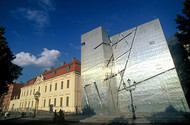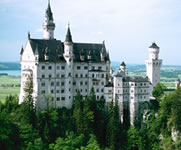Other highlights
Contact
Berlin Tourismus Marketing GmbH
Am Karlsbad 11
10785 Berlin
Email:
information@visitberlin.de
Internet:
www.visitBerlin.de
Am Karlsbad 11
10785 Berlin
Email:
information@visitberlin.de
Internet:
www.visitBerlin.de
Museums

In the heart of the city, Berlin's Museum Island is a treasure trove of mankind and one of the most popular attractions with locals and tourists. The various expositions boast an unrivalled collection of priceless exhibits covering the entire span of human history, from the cradle of civilisation in Mesopotamia through Egypt, Classical Greece and Rome, Byzantium, the Islamic World and the Middle Ages right up to the modern age. Guided tours of the exhibitions are available, larger groups or school trips must be booked in advance. A number of the museums are closed on Mondays.
» Further information
The Jewish Museum in Berlin is a fascinating addition to Europe's museum landscape. A vibrant repository of German Jewish history and culture, the centre serves as a forum for research, discussion and new ideas. The musuem is suitable for everyone – young and old, Germans and foreigners, Jews and gentiles. Public guided tours are held several times a week. Specialist tours of the exhibitions and individual tours on Jewish history and culture can be arranged on request. Closed 30 September-1 October 2008 (Rosh Hashanah), 9 October 2021 (Yom Kippur) and 24 December.
» Further information
The permanent exhibition of the German Historical Museum acquaints visitors with the various periods of German history in their wider European context. Across two levels, historical artefacts are showcased in a wide variety of settings, whiletemporary exhibitions and special events complete the picture. A number of guided tours are on offer to suit various groups and interests. They cover all sections of the museum and take place at set times each day. Individual tours can be booked in advance. The museum is open every day.
» Further information
The private collection of Heinz Berggruen, who was one of Europe's most influential art dealers, is among the most important in the the world. On display are works by the leading exponents of Classical Modernism, including Picasso, Braque, Klee, Laurens, Giacometti and Matisse. Picasso's huge "Reclining Nude", painted in 1942, is the defining work of the Berggruen collection. Closed on Mondays.
» Further information
This memorial incorporates an underground information centre and the "field of stelae". The work of architect Peter Eisenman, this haunting site is populated by 2,711 concrete slabs. All texts are accompanied by English translations, and multilingual headphone guides are available. The field of stelae is open at all times, the information centre is closed on Mondays.
» Further information
Helmut Newton was one of the most popular and influential photographers of the 20th century. The German artist was regarded as a revolutionary in the world of photography, andhis remarkable pictures were the subject of much controversy. Helmut Newton set up this international foundation in 2003 to preserve, protect and showcase his own photographic works and those of this wife June. In accordance with his wishes, the foundation maintains a vibrant, exciting approach to its work. Wheelchair access. Closed on Mondays.
» Further information
This fascinating collection of pathological and anatomical exhibits is housed in the Berlin Charité, the city's university hospital. It was systematically accumulated by Rudolf Virchow, the "father of modern pathology" and a renowned universalist, after he took up a chair at the institute in 1856. The exhibition covers everything from anatomy to heart surgery. Multilingual guided tours available, participants must be at least 16 years old. Closed on Mondays.
» Further information
The Museum of the Ancient Near East was founded in 1899, but its exhibits were shared among several collections until 1930, when the opening of the three-wing Pergamon Museum brought them together under one roof. World-famous archaeological finds from Babylon, Assur, Uruk and Syria form the heart of the collection. Highlights include the market gate of Milet and the Pergamon Altar. While the Ishtar Gate, the Processional Way and the Throne Hall façade, built in Babylon in the first half of the sixth century, were together deemed to be one of the Seven Wonders of the Ancient World. This historic ensemble earned the museum a stellar international reputation. Open daily. Guided tours available.
» www.smb.spk-berlin.de
Reopened in 2006 after refurbishment, the Bode Museum houses the Sculpture Collection, the Museum of Byzantine Art and the Coin Cabinet. The Sculpture Collection is one of the largest of its kind in Germany, spanning a period from the Middle Ages to the tail end of the 18th century. Italian sculptures make up the core of the exhibition, with an additional focus on late-Gothic works and architectural sculptures. The Coin Cabinet, which has around half-a-million exhibits, ranks among the world's largest numismatic collections. It covers virtually the entire history of coinage – from the first minting in Asia Minor around the 7th century BC to the loose change and medals of the 21st century. Also on show is an impressive array of paper money and a collection of historical seals. Open daily. Guided tours available.
» www.smb.spk-berlin.de
Berlin's Charlottenburg Palace was the largest and most magnificent owned by the Hohenzollern dynasty. It was named after Sophie Charlotte, who became Queen of Prussia after marrying Frederick the Victorious, one of the men responsible for its construction. The ensemble is notable for its beautifully decorated interiors, interconnecting rooms arranged enfilade and art galleries featuring acclaimed masterpieces. Visitors can also see Frederick the Victorious and his wife's living quarters, the porcelain cabinet and the apartments used by Frederick the Great. The extraordinary art collection is a must for those interested in paintings from 18th century France, while the French theme continues in the beautiful palace grounds. They were laid out in 1687 by Siméon Godeau as the first baroque gardens in the French style. Highlights include the landscaped boxwood hedges, orange trees and fountains. This splendid historic residence stands as a monument to courtly life from the baroque to the early 20th century. Closed on Mondays, guided tours available.
» www.spsg.de
Based at the legendary border crossing Checkpoint Charlie, the Wall Museum traces the history of the divided Germany. Opened in 1962, it is one of the city's most popular visitor attractions. The diverse collection of exhibits includes the actual tools and equipment used by people in their attempts to flee East Germany. But the most gruesome item on display is the automatic-fire weapon used at the border. Visitors can also learn about the Berlin Wall, its construction and how it came to fall, life in East Germany, the Stasi secret police, justice and the legal system, repression, opposition and resistance, and the escapes to the West, the people involved and the methods employed. Open daily. Guided tours available on request.
» www.mauermuseum.de
Founded in 1985, Berlin's Gay Museum is the world's only exhibition devoted to the systematic research and media portrayal of homosexuality in all its manifestations. The permanent collection, entitled "Pride and persistence – 200 years of gay history", is complemented by regular special exhibitions on the history, culture and everyday life of the gay community. Together, they tell the story of homosexuality down the ages and how gay people used to live. Periods covered include 1871-1918, the Weimar Republic, the Nazi era and the 1950s to the 1980s, and the spotlight also falls on AIDS. The museum presents individual accounts and how certain people lived their lives, while the core exhibits of art, films, photography, fetishes, leather, sadomasochism and bisexuality reflect the everyday realities of the gay world. Closed on Tuesdays. Guided tours on request.
» www.schwulesmuseum.de
Right in the centre of the former US sector, the Allied Museum documents an extraordinary history packed with excitement and drama; the history of the western powers and Berlin during 1945-1994, all presented here in a permanent exhibition. The exhibition includes the famous Checkpoint Charlie border crossing and many other objects relating to political and military history and everyday life at the time. Closed on Wednesdays. Multilingual guided tours on request.
» www.alliiertenmuseum.de
The Stasi Museum is located in Berlin in House 1 of the huge former headquarters complex of the Ministry for State Security of East Germany. Visitors can learn all about the work of the Stasi and the opposition in the GDR between 1945 and 1989. The offices of Erich Mielke, the last East German Minister of State Security, have been maintained in their original condition. The exhibition is divided into three parts: Surveillance – Suppression – Espionage. It features the objects and techniques that were used for spying and observation. Open daily. Guided tours available on request.
» www.stasi-museum.de
This interactive exhibition takes you on a spectacular journey through the history of the German capital, from the first documented reference to the city in 1237 to the present day. Multimedia displays tell visitors about people, places and stories in 20 themed rooms over four floors, a total exhibition area of 6,000m˛. The highlight is a guided tour of a nuclear bunker beneath the Ku’damm Karree shopping arcade, which was built to accommodate 3,600 people. It still has its original interiors and is ready for use, giving a realistic impression of the Cold War period. Guided tours on request.
» www.story-of-berlin.de
The botanical garden, created between 1897 and 1910 and covering an area of 43 hectares, boasts around 22,000 different plant species, making it one of the largest and most important botanical gardens in the world. It also includes the Botanical Museum which has models of flowers and vegetation, ancient Egyptian burial objects, etc. The botanical garden's cathedral-like greenhouses contain some of Germany's largest collections. The 25-metre-high tropical house is the tallest greenhouse in the world. The giant Victoria water lilies are also well worth admiring. Disabled facilities, guided tours on request.
» www.botanischer-garten-berlin.de
The Airforce Museum of the German Federal Armed Forces is located in Gatow at the former military airfield. It presents an exhibition of German military aviation and the air force, from its beginnings to the present day. Runways, hangars and the barracks to the south were constructed in 1934/35 as part of an elite training centre for officers and general staff officers. On the former Gatow airfield, in hangars and around the control tower which now houses a museum, many military vehicles and air defence systems from the First World War onwards are on display. There is considerable emphasis on the history of the West German Federal Armed Forces and the East German National People's Army and their alliances, from the period of confrontation to the reunification of Germany in 1990. Closed on Mondays. Guided tours on request.
» www.luftwaffenmuseum.de
The MACHmit Museum in Berlin offers children and adults heaps of fun, exciting experiences and fascinating discoveries. There is lots of exhibition space (approx. 1,200m˛) in which to play, climb, join in with hands-on activities, experiment, try things out and look at the exhibits. Permanent attractions include a 7-metre tall climbing labyrinth, a hall of mirrors and a museum print workshop (visitors make up texts and do hot-metal typesetting), an art laboratory (microscopes, micro-organisms and art), a 1920s soap shop and a play area with sensory experiences for very young children. The museum also offers English through play, workshops and a varied accompanying programme. Closed on Mondays. Guided tours on request.
» www.machmitmuseum.de
Travel Planner
Select an option...
Hotel search
Map of Germany
Hotels in Berlin
Loading







